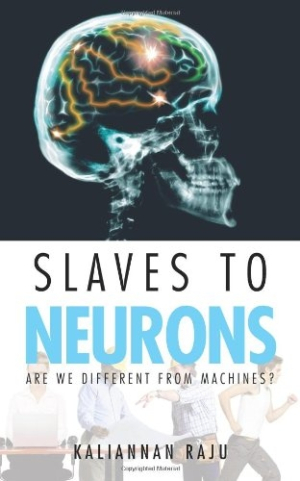Slaves to Neurons
Are We Different from Machines?
In Slaves to Neurons, Kaliannan Raju investigates the near future of robotics and the nature of human consciousness through the lenses of authentic and imagined science. Pete McRae, a neurologist-cum-robotics engineer, is bedeviled by the notion that the human mind—that is, spirit, emotion, memory, intelligence—is “nothing but a neural phenomenon.” To probe his theory, McRae sets out to build a brain that can house human traits like the ability to learn, love, and think.
Then, as always, things go terribly wrong. McRae, like Herr Frankenstein before him, forgets that technology is no panacea. It is as fallible as any man. He puts the brain into the body of an existing robot. (The procurement and use of the robot is a high point of the novel, combining both suspense and hard science.) Yet when McRae loses the ability to control his creation, he exposes his family to very real danger.
Slaves to Neurons challenges the reader with long discourses on what it is to be a human or a robot. “Imagine,” thinks McRae, “we are no different from the robots that we have developed—because we follow the same laws of physics and those are the only laws we abide by and nothing else governs us.” McRae’s wife, a being of more humanist convictions, is not so inclined: “The human spirit. How can you put that in a machine?”
The novel’s dialogue is often fascinating and, according to Raju’s postscript, is rooted in incipient developments in technology. Readers may be tempted to seek out the books McRae refers to in his disquisitions, so enthusiastic are his references to them.
While Raju’s fervor for his topic is evident and contagious, the technical details he provides are overabundant. They are injected via expository dialogue that is routinely more like a TED talk than a work of fiction. Where authors like Michael Crichton have succeeded in this genre, Raju stumbles because he neglects the fabric of story: namely arc, character, mood, and scene. Instead of building a world, he creates a presentation.
However, it is worth noting that Raju’s scenes take on much more immediacy when the brainy robot enters the picture: the prose becomes more personal and enveloping. We see the robot waking, learning, moving in real time, not filtered through a conversation or memory. It is as if Raju is more comfortable writing concrete imagery once his target subject has appeared. There are other moments of stronger writing that transcend his otherwise flat style. Those are the moments when Raju, clearly a thoughtful writer, is in his element.
The novel’s flaws persist in more mechanical ways, too. There are numerous punctuation errors and other mistakes: The name Brian often becomes Brain; the word “decent” appears as “descent.” Dialogue markers lack commas.
Were its problems resolved, this novel could function as an auxiliary educational tool for young adult readers interested in robotics, neuroscience, or nanotechnology. Raju’s topic is timely, fascinating, and thoroughly researched.
Reviewed by
Leia Menlove
Disclosure: This article is not an endorsement, but a review. The publisher of this book provided free copies of the book and paid a small fee to have their book reviewed by a professional reviewer. Foreword Reviews and Clarion Reviews make no guarantee that the publisher will receive a positive review. Foreword Magazine, Inc. is disclosing this in accordance with the Federal Trade Commission’s 16 CFR, Part 255.

